![]()
![]()
![]()
Use LEFT and RIGHT arrow keys to navigate between flashcards;
Use UP and DOWN arrow keys to flip the card;
H to show hint;
A reads text to speech;
26 Cards in this Set
- Front
- Back
|
Today's Agenda for Session 8:
|
Building High Performance Teams
Team performance tools – RACI – GRPI – Plus Delta – Leadership Sheel BA Managing Change |
|
|
What are some stages of Team Development?
|
-Teams, once formed, do not automatically launch themselves to heights of high performance.
-Unlike the situation of a person working alone, there is the factor of group dynamics to contend with. As soon as a number of people are thrown together, the various expectations, needs, personal agendas and personal styles now come into play. -Communication channels are expanded and therefore the possibility of misunderstanding is increased. -For teams to evolve, they often pass through a number of stages of development. Each stage has its own particular challenges and tasks |
|
|
What is Tuckman's five stage model of team development?
|
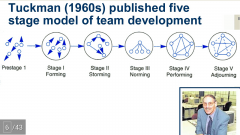
Prestage 1
Stage 1: Forming Stage 2: Storming Stage 3: Norming Stage 4; Performing Stage 5: Adjourning |
|
|
What are some aspects of Storming?
|
This is the terrible twos of team development. This is where the different styles and expectations start to rub against each other.
It is a time for testing, where team members may come out to vie for leadership.The big question here is often, Who's in charge? Even through the formal leader is established there is still room to test for autonomy and the informal leadership within the team There may some different expectations about how fast the team needs to go. There may be differences around the purpose or focus of the team. People may have different decision making styles that may start to conflict. In addition there may be irritation when people perceive that others are intruding into their turf. It is at this stage where polite conversation is replaced with interruptions, people trying to talk over others, poor listening, and unfocussed discussion. The problem with Storming is that unless there is a conscious effort to remedy some of the differences and mitigate the frustrations, the storming can become chronic and long standing. It may be that outright hostility gets replaced by more civilized behaviour, but underneath the resentment and lack of trust remains |
|
|
What are some aspects of Norming?
|
At some point the team starts to resolve its conflicts.
This could be as a result of an explicit clarification of goals and process or the setting of rules of conduct. The team members may make an implicit agreement on informal leadership and other boundaries. It is at this stage that people start valuing the diversity within the team and to appreciate the various styles. People start viewing the other team members as important allies as opposed to competitors. As a result there is greater comfort in expressing opinions and needs. Problem solving improves and so does consideration for others. |
|
|
What are some aspects of Performing?
|
If norming continues, the team eventually reaches a point where their task orientation and relationships are focused and effective.
Trust levels are high and as a result hidden agendas are minimized. People genuinely appreciate the views of fellow team members. There is little hand-holding required of a team at this stage of development. The challenge to performing is that it may take a while to reach this stage. Also, if the team composition changes with different membership, there is a tendency to revert to a previous stage, as the team seeks to reassert its norms. |
|
|
Diagram of stages of team development:
|
-Get into your team groups to discuss your
team performance on your project. -What stage are you currently performing at? -What other stages do you recognize? -If you are not at the performing stage, how might you get there? |
|
|
What are the 6 basics of team performance?
|
1. Small number
2. Complementary skills 3. Common purpose 4. Common set of specific performance goals and objectives 5. Commonly agreed upon way of doing things. 6. Members hold themselves and each other, mutually accountable |
|
|
What is the RACI team performance tool?
|
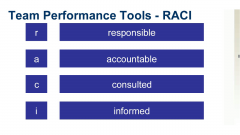
|
|
|
A diagram of RACI tool Person vs. Task.
|
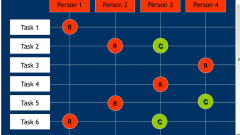
|
|
|
Another visual chart for RACI
|
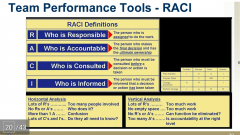
|
|
|
Aspects of GRPI Team performance tool:
|

-One way to look at team effectiveness is to assess the team in a number of important elements.
-Effective teams have clear, well understood goals. -Also the various roles on the team are established and understood. -The team also has established some team processes. -This could include protocols on frequency of meetings, and how the team will make decisions or communicate externally to the team. -Finally, an effective team is characterized by strong and healthy interpersonal relationships. Members recognize and respect each other. They have learned to accommodate and build on the diversity of the team members. |
|
|
GRPI broken down:
|
G: Goals, Results:
Does the team have specific goals, objectives? Are people aware of goals? Do we know what we focus on, Vs. not focus on? R: Roles: Are roles clear? Do people know what their work is..who does what? Are boundaries clear? P: Process How does the team plan its work? -Is the team process well facilitated? -Did the group use effective problem solving skills? -Are there procedures re: communication, decision making? I: Interpersonal -Is there trust among team members? -Do the members listen to the different points of view? -Do the team recognize different styles/preferences? -Do the members support each other? |
|
|
GRPI Diagnosis diagram
|
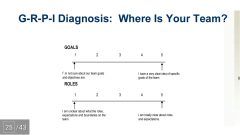
|
|
|
GRPI Diagnosis: Where is your team?
|
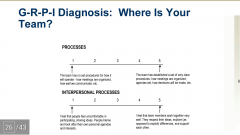
|
|
|
GRPI Diagnosis: Team Survey
|
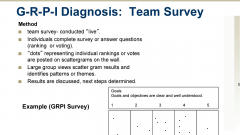
|
|
|
Team Performance Tools - Plus Delta
|
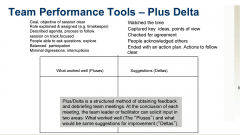
|
|
|
Plus Delta Example
|
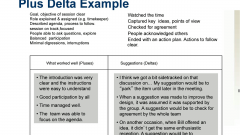
|
|
|
Team Performance Tools – Setting
ground rules |
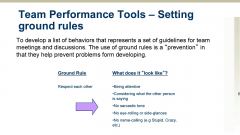
|
|
|
Team Performance Tools – Team Types
|
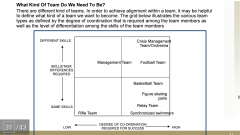
|
|
|
Team Performance Tools – Team Types Part 2
|

|
|
|
What is Round Robin Polling?
|
What It Is
Often in teams, the discussion becomes dominated by a few more active and vocal members. This results in an imbalance of participation. Over time, there is a risk that the more quiet members start to withdraw and as a result their input or comments are lost to the team. Round Robin is simply an approach that attempts to seek input from everyone at a team meeting. Method On every important issue or key point that is raised, the leader or facilitator pauses to check in with other team members. This can be as simple as going around the table, asking each person if they have anything to add or what their opinion might be. In conducting this around this around-the-table polling, it is sometimes better to ask open questions, What do you think about the proposal?, What reaction do you have?, as opposed to closed questions, Do you wish to add anything? A variation of the Round Robin is when starting to generate ideas, give everyone a few minutes to write down their own thoughts first, then go around the table collecting the various ideas. This particular technique allows for the more reflective, quieter members to gather their thoughts prior to the discussion. |
|
|
Diagram of traditional project team
|
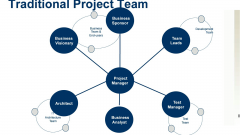
|
|
|
Core project team concept diagram:
|
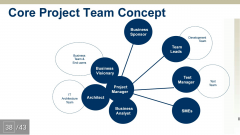
|
|
|
BA Managing Change, BAs should do what?
|
BAs should:
-Identify specific organizations and jobs that will be impacted -Investigate Individual business persons and their attitudes towards the change -Determine potential discussions that can be facilitated -Discover concerns that need to be addressed in order to potentially move stakeholders from a nonsupportive to a supportive position |
|
|
What are BA Managing Change Tips:
|
Seek support and reward it!
-Choose your battles wisely. -Be tolerant of mistakes. -Be patient – acceptance takes time. -Embrace the future. -Recognize and reward accomplishment |

